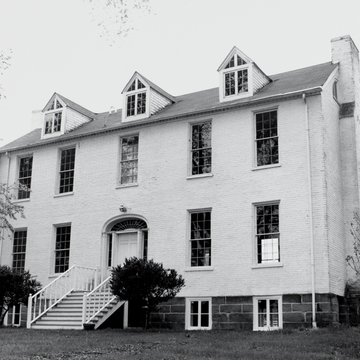You are here
Jenkins Plantation Museum (Gen. Albert Gallatin Jenkins House; Greenbottom)
Slaves of the Jenkins family, who settled here in the 1820s, likely guided “the plough [s] of civilization” that eradicated the surface remains of the ancient city that once stood on the site. William Jenkins acquired a 4,441-acre tract and lived with his family in temporary quarters until completing the Federal house now known as Greenbottom. The rectangular two-story brick house, one of the region's significant architectural and historical resources, stands high on a cut sandstone foundation. Attenuated proportions of its fenestration and the elliptical-arched main entrance are particularly notable. Such features, long out of date when the house was constructed, reflect architectural precedent and habit with which Jenkins, who had lived earlier in Rockbridge County, Virginia, far to the east, was familiar. The all too prominent dormers on the riverfront and a frame wing to the north are later alterations. A once expansive group of outbuildings has disappeared.
Jenkins's son, by whose name the house is often called, was a Harvard-educated, two-term U.S. congressman, Confederate congressman, and brigadier general in the Confederate army. He died in 1864, at age thirty-three, from wounds suffered during the war.
In 1988 the U.S. Army Corps of Engineers bought 836 acres of the Jenkins property, including the house and curtilage, to develop the area as wetlands. The aim was to mitigate the destruction of waterfowl habitat caused by expansion of the Gallipolis Locks and Dam, upstream on the Ohio River. The land became the Greenbottom Wildlife Management Area. The house was stabilized, leased to the state's Division of Natural Resources, and used as offices and staff residence. In 1996 the Division of Natural Resources transferred the house and yard to the Division of Culture and History, and it is now open by appointment. Plans call for the restoration of the house as the centerpiece of the Jenkins Plantation Museum, illustrating the history of the area and the plantation economy that once prevailed on this side of the Ohio River.
Writing Credits
If SAH Archipedia has been useful to you, please consider supporting it.
SAH Archipedia tells the story of the United States through its buildings, landscapes, and cities. This freely available resource empowers the public with authoritative knowledge that deepens their understanding and appreciation of the built environment. But the Society of Architectural Historians, which created SAH Archipedia with University of Virginia Press, needs your support to maintain the high-caliber research, writing, photography, cartography, editing, design, and programming that make SAH Archipedia a trusted online resource available to all who value the history of place, heritage tourism, and learning.














